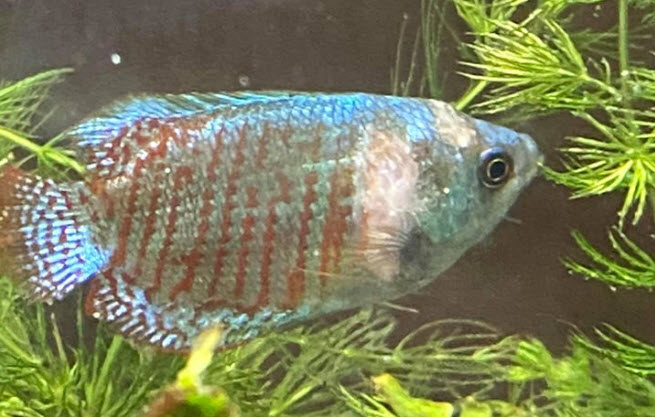
A comment to this page is helpful here:
“We have just lost six out of seven dwarf gouramis. They all died over the course of 3 weeks with some going very quickly and others dying slowly. I expect the last one to go any day now. It is such a shame as they are beautiful fish with amazing personalities but I won’t be purchasing anymore. It’s awful watching, waiting for them to die. I knew nothing of this disease before purchasing them and when I asked my local shop about it (after purchase) they just said dwarfs are more susceptible to some illnesses.”
There is a very beautiful fish which many beginners buy for their aquarium called the “dwarf gourami” (Trichogaster lalius). It comes in a host of beautiful varieties including powder blues, flame reds and neon blues. We do not recommend buying any dwarf gouramis, period. At least 50% of them will die in six months to a year due to an incurable virus disease.
This disease seems to be a combination of a virus AND a defect that occurs with interbreeding dwarf gouramis. It has not been found in wild strains of the dwarf gourami. I suspect breeders will figure out the genetics and start breeding resistant strains soon.

Dwarf gourami disease seems to infect gouramis when they are very young and then pop up and kill them rapidly six months to a year later. And typically it won’t spread to other species of fish. So, if you have dwarf gouramis already, you can safely leave the dwarf gouramis in a community tank. And note that maybe you will be one of the lucky ones whose dwarf gouramis do not have the virus.
Dwarf gourami disease is contagious among dwarf gouramis when they are fry. BUT if a dwarf gourami in a tank full of dwarf gouramis starts showing symptoms of the disease, ALL the other dwarf gouramis will have the virus and will probably soon show symptoms. So there is little point to quarantining or euthanizing.

Starting about 2008, aquarium dealers and hobbyists noticed a greatly increased mortality rate in all varieties of dwarf gouramis (Trichogaster lalius). It appears to be largely due to a virus. The virus is called an “infectious spleen and kidney necrosis virus (ISKNV)”. This virus is a megalocytiviruse, a type of iridovirus (“Iridovirus Disease in Two Ornamental Tropical Freshwater Fishes: African Lampeye and Dwarf Gourami”, Sudthongkong et. al., 2002). The virus appears to have originated in Southeast Asia but it has now spread to pretty much all populations of inbred dwarf gouramis.
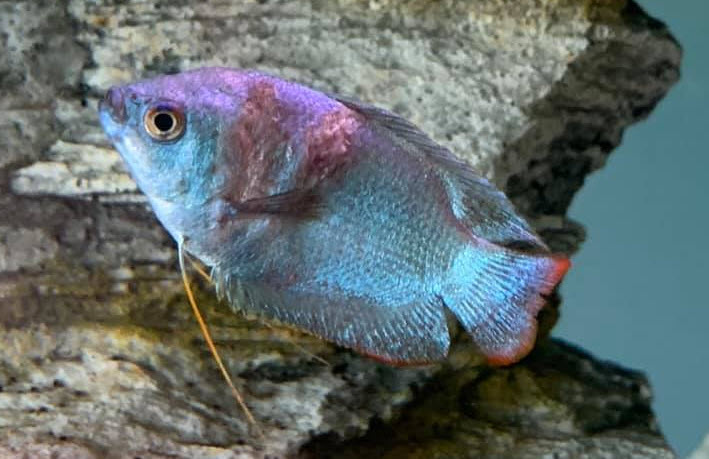
Symptoms are varied and include loss of appetite, bloat, bumps, lesions on the body, patches of pale or white coloration (especially prevalent on the head) and high mortality rate. Basically ANYTHING unusual on the skin of a dwarf gourami indicates they have the virus. Just a small lump is a problem with a dwarf gourami. Often the fish simply die overnight with no symptoms.
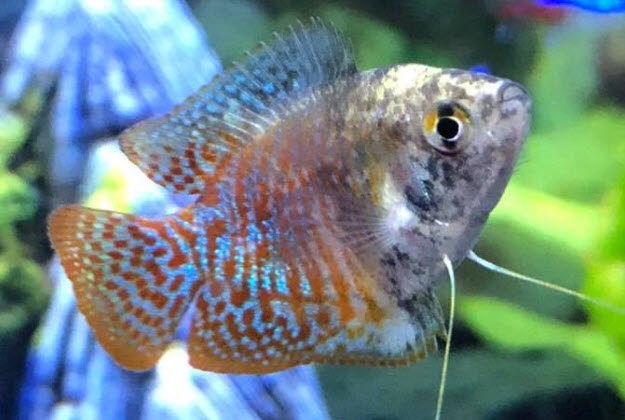
The virus is very unusual in that it appears to lie dormant for six months to a year. It then breaks out and typically kills the dwarf gourami very quickly, in one to ten days. If there are more than one dwarf gourami in a tank they often will die at intervals of a month or more. As it is a virus there simply is no cure. The virus which causes this disease has only rarely been found in other tropical fish. But it is a deadly plague to the dwarf gourami. Virtually all the time dwarf gourami disease does not spread to other fish.
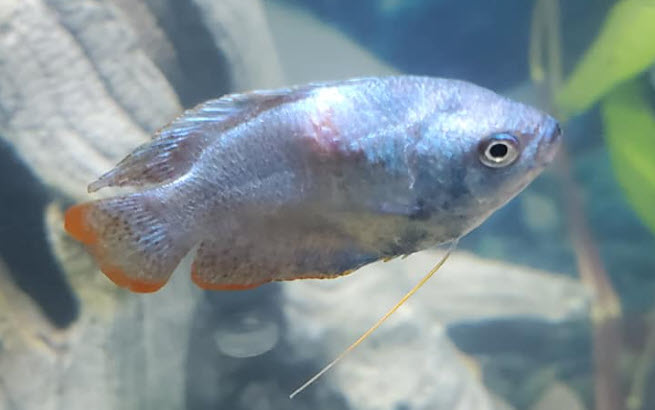
It is possible that, like many other intractable and incurable fish diseases, dwarf gourami disease responds well to having a crystal clear, well filtered tank with UV sterilization. But this is an unproven hypothesis.

The honey gourami (Trichogaster chuna) is a good substitute as they are only about two inches long (dwarf gourami get to 3 1/2 inch). The honey gourami is just a golden yellow to orange without the blue or red coloration of the dwarf but it doesn’t appear to get dwarf gourami disease. The honey gourami is also more mellow than the dwarf gourami.
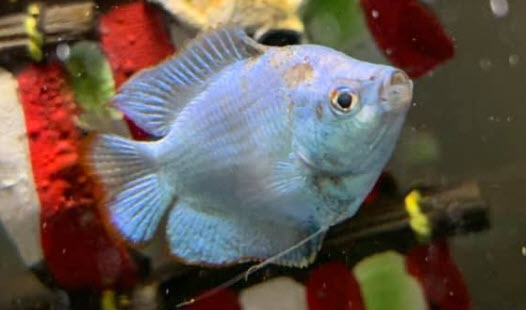
Return to Diseases Menu
.
Aquarium Science Website
The chapters shown below or on the right side in maroon lead to close to 400 articles on all aspects of keeping a freshwater aquarium. These articles have NO links to profit making sites and are thus unbiased in their recommendations, unlike all the for-profit sites you will find with Google. Bookmark and browse!
.

Dave says
In reply to Mike …… Sounds like one of the lucky ones.
Mike says
Hi Dave , so I’ve had a powder blue dwarf. I brought home before I’d heard of the disease. Anyway I’ve had him for 14 months. Would you say after that long that maybe he’s one of the lucky ones and doesn’t have it or could it still happen after all this time?
Rebecca S Leader says
I have a beautiful powder blue dwarf gourami that I named Blue Bob, after my brother. My brother died of cancer, and now I have to watch Blue Bob die. It’s so strange, he is very active, and has a great appetite. I know that I’m going to lose him, and it makes me very sad. I had an orange flame gourami that died. He was named George, after another brother that cancer took from us. Makes me so sad. 😞😞😞
Dave says
In reply to Stephen …. The “honey gourami” is not an inbred version of a “dwarf gourami”. It is a separate species and NOT susceptible to dwarf gourami disease
Stephen P Brady says
Confusing… So, is a Honey Gourami a Dwarf or not?
“The honey gourami (Trichogaster chuna) is a good substitute as they are only about two inches long (dwarf gourami get to 3 1/2 inch). The honey gourami is just a golden yellow to orange without the blue or red coloration of the dwarf but it doesn’t appear to get dwarf gourami disease”
“chris says
2024-01-29 at 6:50 pm
Sorry I realise my previous post is a bit ambiguous. I meant to say the more highly line bred versions such as Peacock and Powder Blues and the Honey Dwarf are more susceptible. Stick to the ones closer to wild stock.”
Xmegatron doug says
That’s terrible. I have a male gold Gourami and female Opaline Gourami 🔵 I will add 4 redeye tetras and 1 single male nannacara cichlid his friends will be Florida flagfish.
chris says
Sorry I realise my previous post is a bit ambiguous. I meant to say the more highly line bred versions such as Peacock and Powder Blues and the Honey Dwarf are more susceptible. Stick to the ones closer to wild stock.
Chris says
It is a DNA virus which the severe inbreeding of Dwarf Gouramis has made them susceptible. Iridovirus is it’s scientific name and it is also a problem in aquaculture farms. Getting Dwarf Gourami closer to Wild stock such as the traditional red stripe and even the flame versions have a greater resistance to the condition. Peacock and Powder Blues and the Honey Dwarf variety.
I agree with you all, it is heart breaking to see these interesting, colourful and active fish die with nothing you can do. Currently I have some healthy specimens but one of the females has started to exhibit early signs. 🙁
Leonard Perkins says
First time i have every heard anything about Gouramis illness.sins having them for the last four months.lost one in plastic oniment before.hence now i check wether they can fit through & bury the ornament.in the gravel or sand.am deversted i have to watch him die & cart help.am going to put him on his own.next to other tank as am hopping the other two love on.i will let the ppl no my feelings.to some degree am not happy.they never told me to look out for any white bumps on them.
Hayley says
This makes me sad to read as our gourami have this disease, I just found out about it doing research here! He is my favourite fish in the tank and I wish I knew about this sooner as it is going to be awful watching him deteriorate 😢 we are beginners so I’m glad to know it’s nothing we have done wrong
Dave says
In reply to Lil … Greed. Pure and simple Greed. As long as they can make a profit they will sell them.
Lil Waddle says
If the disease is pretty assured in Dwarf Gouramis, why do pet stores still sell them? They are a beautiful fish, we’ve had 10-12 of them, but for the g Chu ost and there eventual death why sell them to public?
Emma says
We have just lost 6/7 dwarf gouramis, they all died over the course of 3wks with some going very quickly and others dying slowly. I expect the last one to go any day now. It is such a shame as they are beautiful fish with amazing personalities but I won’t be purchasing anymore, it’s awful watching, waiting for them to die. I knew nothing of this disease before purchasing them and when I asked my local shop about it (after purchase) they just said dwarfs are more susceptible to some illnesses.
Dave says
In reply to Kouta …. I’ve never seen anything about it. But since it seems to be limited to highly inbred lines of dwarf gouramis and hasn’t been found in wild dwarf gouramis I suspect that other gouramis can’t carry the disease.